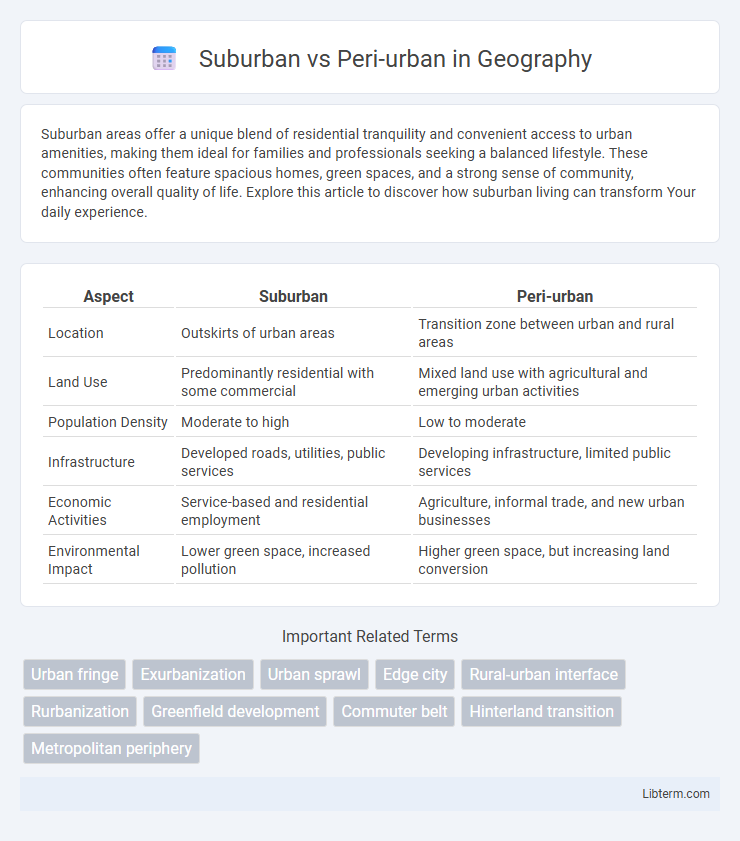Suburban areas offer a unique blend of residential tranquility and convenient access to urban amenities, making them ideal for families and professionals seeking a balanced lifestyle. These communities often feature spacious homes, green spaces, and a strong sense of community, enhancing overall quality of life. Explore this article to discover how suburban living can transform Your daily experience.
Table of Comparison
| Aspect | Suburban | Peri-urban |
|---|---|---|
| Location | Outskirts of urban areas | Transition zone between urban and rural areas |
| Land Use | Predominantly residential with some commercial | Mixed land use with agricultural and emerging urban activities |
| Population Density | Moderate to high | Low to moderate |
| Infrastructure | Developed roads, utilities, public services | Developing infrastructure, limited public services |
| Economic Activities | Service-based and residential employment | Agriculture, informal trade, and new urban businesses |
| Environmental Impact | Lower green space, increased pollution | Higher green space, but increasing land conversion |
Defining Suburban and Peri-urban Areas
Suburban areas are residential zones located on the outskirts of a city, characterized by moderate population density, primarily housing communities with access to urban amenities and infrastructure. Peri-urban areas lie at the interface between urban and rural zones, exhibiting mixed land use with evolving urban features alongside agricultural activities and lower population density. The key distinction involves land use and development intensity, where suburban areas are more developed and urbanized compared to the transitional and often less structured nature of peri-urban zones.
Key Differences in Location and Proximity
Suburban areas are typically located on the outskirts of major cities, characterized by established residential neighborhoods with direct access to urban amenities and infrastructure. Peri-urban regions, however, exist at the transitional zone between urban and rural areas, often featuring mixed land uses and less dense development. The key difference lies in proximity: suburban zones maintain closer ties to city centers, facilitating daily commuting, while peri-urban areas serve as buffers with more agricultural or undeveloped land bordering urban expansion.
Population Density Comparison
Suburban areas typically exhibit moderate population density, balancing residential, commercial, and green spaces with densities ranging from 1,000 to 3,000 people per square mile. Peri-urban zones, located at the edges of urban growth, often have lower population densities, usually between 500 and 1,500 people per square mile, reflecting a mix of rural and urban land uses. This stark contrast in density influences infrastructure development, transportation patterns, and housing demand in both suburban and peri-urban regions.
Land Use and Zoning Patterns
Suburban land use patterns typically feature low-density residential developments characterized by single-family homes, commercial zones concentrated along main corridors, and well-defined zoning regulations supporting organized growth. Peri-urban areas exhibit a complex mix of agricultural land, emerging residential developments, and fragments of industrial zones with less rigid zoning controls that allow for diverse and transitional land uses. The dynamic zoning framework in peri-urban regions often results in a mosaic of land uses, reflecting the tension between urban expansion and rural preservation.
Infrastructure and Accessibility
Suburban areas typically feature well-developed infrastructure with established road networks, public transportation, and utilities supporting residential and commercial zones. Peri-urban regions often have less comprehensive infrastructure, experiencing rapid development but facing challenges in consistent accessibility and service delivery. Infrastructure investment in peri-urban zones is crucial to bridge accessibility gaps and accommodate expanding populations.
Socioeconomic Profiles
Suburban areas typically exhibit middle to upper-middle-class socioeconomic profiles, characterized by higher income levels, homeownership rates, and access to quality education and healthcare facilities. Peri-urban zones often feature a mix of rural and urban livelihoods, with diverse income levels and occupations including agriculture, informal labor, and emerging industrial work, resulting in varied access to social services. Population density and infrastructure development in suburban regions tend to be more advanced compared to peri-urban areas, influencing disparities in economic opportunities and living standards.
Environmental Impacts
Suburban areas typically experience moderate environmental impacts characterized by increased land consumption, habitat fragmentation, and higher carbon emissions from commuter traffic. Peri-urban regions face more intense environmental challenges including rapid land-use change, loss of agricultural land, and greater water resource strain due to mixed urban-rural development patterns. Both zones contribute significantly to urban sprawl but peri-urban areas often exhibit more pronounced biodiversity loss and ecosystem degradation.
Housing Types and Development Trends
Suburban areas predominantly feature single-family detached homes with uniform architectural styles, reflecting planned, low-density residential development trends aimed at family living. Peri-urban zones exhibit a more heterogeneous mix of housing types, including rural cottages, small apartment complexes, and informal settlements, driven by rapid urban sprawl and transition from agricultural to mixed-use land. Development trends in suburban neighborhoods emphasize master-planned communities and infrastructure, whereas peri-urban regions face fragmented growth with evolving land use and less regulated construction patterns.
Challenges and Opportunities
Suburban areas face challenges such as urban sprawl, traffic congestion, and limited public transportation, while offering opportunities for affordable housing and community development. Peri-urban zones encounter issues like land-use conflicts, inadequate infrastructure, and environmental degradation, yet present potential for sustainable agriculture and integrated urban-rural planning. Effective management of these areas requires balancing growth with ecosystem preservation and enhancing connectivity between urban centers and surrounding regions.
Future Growth and Urbanization Dynamics
Suburban areas are expected to witness moderate growth driven by infrastructure expansion and increased demand for residential spaces near metropolitan hubs. Peri-urban zones, characterized by rapid unpredictable development, are becoming critical hotspots for urban sprawl due to flexible land use policies and proximity to both rural and urban markets. Future urbanization dynamics indicate peri-urban regions will play a vital role in accommodating population overflow, balancing economic activities, and shaping sustainable metropolitan growth patterns.
Suburban Infographic

 libterm.com
libterm.com